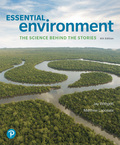
To explain: The way in which competition promotes resource partitioning.
Answer to Problem 1TYC
Competition promotes resource partitioning so that both species can co-exist without the elimination of any species.
Explanation of Solution
The interaction among species poses threat in the fabric of ecological communities. Ecologists organize interaction among species into several categories such as competition, predation, herbivory,
Competition is the relationship that is said to present when multiple organisms seek the same limited resource. This relationship not always includes fight with other species physically or directly but it is generally subtle and indirect. This involves vying of organism with one another to “procure resources” and such resources include water, food, shelter, sunlight, mates, space and many more.
This type of interaction takes place between either members of same species resulting in intracellular competition or between members of different species that is interspecific competition. If one species is much effective competitor then it may exclude the other species entirely for resource which will result in imbalance. Alternatively if species may able to exist together, adapting over evolutionary time (natural selection) then they can use the resource in shared manner. This process is known as “resource partitioning”.
Want to see more full solutions like this?
- the questions often be used to determine the age ofmetamorphic rocks.Questions1. List the relative age of the rocks in Figure 2with oldest first.2. What stratigraphic principles did you use todetermine the age of the rocks in Figure 2?3. If layer A is 418 Ma and layer B is 388 Ma, what geological Period(s) are layers C and D likely to befrom?4. Layer C contains fish fossils.a. Circle the rock type for layer C. Igneous Sedimentary Metamorphicb. Explain how the fish fossils could be used to determine the date of rocks elsewhere.c. Outline possible reasons why the other layers do NOT contain fossilarrow_forwardDiscussion Question: Atmospheric Energy and Global Temperatures Albedo values (% reflected) Fresh snow 80%-95% Grass 25-30% Forests 10%-20% Crops, grasslands 10%-25% Asphat (black top 5%-10% Cancel 17-27 Moon Water bodies 10%-60% (varies with Sun altitude) Earth's albedo (average) 31% Dark roof 8%-18% Light roof 35%-50% Brick, stone 20%-40%arrow_forwardOutline of topic: Increased urbanization together with climate changes forces cities to find solutions for their simultaneous water shortage and flooding problems. The preservation of water resources needs sustainable urban water management strategies that combine ecological health maintenance with these priorities. This study investigates combined strategies that involve rainwater collection together with wastewater treatment and the deployment of green infrastructure consisting of urban wetlands alongside permeable pavements. The research aims to discover multi-purpose solutions that decrease flood dangers together with water shortages while maintaining ecological health for long-term urban water management success. The research investigates ways in which novel solutions assist cities to create watertight urban areas capable of handling environmental pressures from global warming and population expansion. Research questions: What are the economic, environmental, and social benefits…arrow_forward
- Title: Implementing low impact development: Sustainable water management solutions for urban areas Research questions: What are the economic, environmental, and social benefits of integrating wastewater recycling systems into urban water management practices? What methods can cities employ to resolve water supply needs with natural resource defense while achieving long-term water resource sustainability? Please answer all questions in the pictures in detailarrow_forwardMap 2. Parts 1 through 7. I Dont understand how to answer these questions on the map. Please help me step by step.arrow_forwardI desperately need help understanding and doing assignment step by step please. Parts 1 through 7 for the one question.arrow_forward
- Map 2 parts 1 through 7. I need help with the steps and to understand how to complete the assignment. 1) On the map, draw a single red pencil line that represents the kern river recharge axis. 2) on the map draw 3 to 5 additional red lines in closing what appear to be other smaller recharge areas, possibly the locations of isolated individual recharge points. 3) on the map, draw for useful spaced blue pencil lines that represent groundwater flow from the kern river recharge access into the basin north of the river. 5) on the map, draw any necessary, additional blue pencil lines to fully illustrate groundwater flow from the current river recharge axis. 6) what is the groundwater gradient immediately north of the main recharge area? 7) what is the groundwater gradient immediately south of the main recharge area?arrow_forwardPlease answer all questions and all part questions in detail and show all workarrow_forwardPlease answer all questions in detail and show all workarrow_forward
- Please show all workarrow_forwardplastic bottles are better than glass bottles due to their cost-effectiveness, practicality in transportation and use, and advancements in sustainable production. How is this true?arrow_forwardShale and siltstone volcanic ash. erosjon surfaçe limestone sandstone erosion surface pegmatite granite slate dike BUY Aparrow_forward
 Applications and Investigations in Earth Science ...Earth ScienceISBN:9780134746241Author:Edward J. Tarbuck, Frederick K. Lutgens, Dennis G. TasaPublisher:PEARSON
Applications and Investigations in Earth Science ...Earth ScienceISBN:9780134746241Author:Edward J. Tarbuck, Frederick K. Lutgens, Dennis G. TasaPublisher:PEARSON Exercises for Weather & Climate (9th Edition)Earth ScienceISBN:9780134041360Author:Greg CarbonePublisher:PEARSON
Exercises for Weather & Climate (9th Edition)Earth ScienceISBN:9780134041360Author:Greg CarbonePublisher:PEARSON Environmental ScienceEarth ScienceISBN:9781260153125Author:William P Cunningham Prof., Mary Ann Cunningham ProfessorPublisher:McGraw-Hill Education
Environmental ScienceEarth ScienceISBN:9781260153125Author:William P Cunningham Prof., Mary Ann Cunningham ProfessorPublisher:McGraw-Hill Education Earth Science (15th Edition)Earth ScienceISBN:9780134543536Author:Edward J. Tarbuck, Frederick K. Lutgens, Dennis G. TasaPublisher:PEARSON
Earth Science (15th Edition)Earth ScienceISBN:9780134543536Author:Edward J. Tarbuck, Frederick K. Lutgens, Dennis G. TasaPublisher:PEARSON Environmental Science (MindTap Course List)Earth ScienceISBN:9781337569613Author:G. Tyler Miller, Scott SpoolmanPublisher:Cengage Learning
Environmental Science (MindTap Course List)Earth ScienceISBN:9781337569613Author:G. Tyler Miller, Scott SpoolmanPublisher:Cengage Learning Physical GeologyEarth ScienceISBN:9781259916823Author:Plummer, Charles C., CARLSON, Diane H., Hammersley, LisaPublisher:Mcgraw-hill Education,
Physical GeologyEarth ScienceISBN:9781259916823Author:Plummer, Charles C., CARLSON, Diane H., Hammersley, LisaPublisher:Mcgraw-hill Education,





